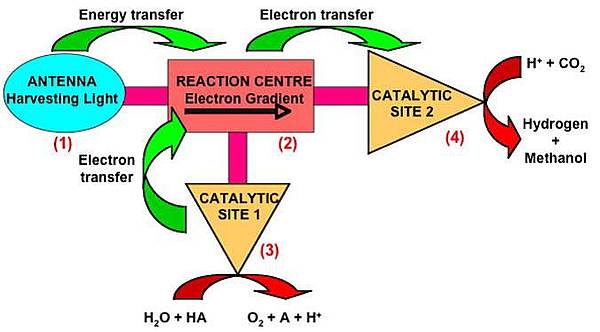The major challenge in the area of renewable energy is devise sustainable ways of making fuels, preferably dense portable fuels that can be used for applications such as aviation. There is one major biochemical/chemical process on Earth that can use solar energy to make fuels and this is photosynthesis. The problem, however, of using photosynthesis (P/S) directly to make fuels (biofuels) is the rather low efficiency of conversion of solar energy into fuel. However, if it were possible to ‘tap into’ P/S at the level of the primary reactions then, in principle, higher energy conversion efficiencies are possible (1). This is the idea behind the drive for artificial photosynthesis. Fig.1 shows how P/S can be broken down into 4 partial reactions. Worldwide there has been a lot of work designed to understand the molecular details of these key four steps in photosynthesis (2). There has been excellent progress in understanding steps 1 and 2, indeed there are now many artificial reaction centre and antenna mimics that function rather well (eg. 3,4). The major barriers to building systems capable of using solar energy to make fuels are our current inability to produce robust catalysts that can split water and use the reductant produced to synthesise a fuel (steps 3 &4). The main aims of this proposal are to work towards the production of novel devices that can overcome these barriers.
 |
Project Leader:
Professor Richard Cogdell
University of Glasgow, Glasgow Biomedical Research Centre, IBLS, Glasgow, UK
Principal Investigator:
Professor Sebastian Mackowski
Nicolaus Copernicus University, Torun, PL
Associated Partners:
Professor Leroy Cronin
University of Glasgow, Faculty of Physical Sciences, Glasgow, UK
Professor Wolfgang Lubitz
Max-Planck-Institut für Bioanorganishe Chemie, Mülheim, DE

